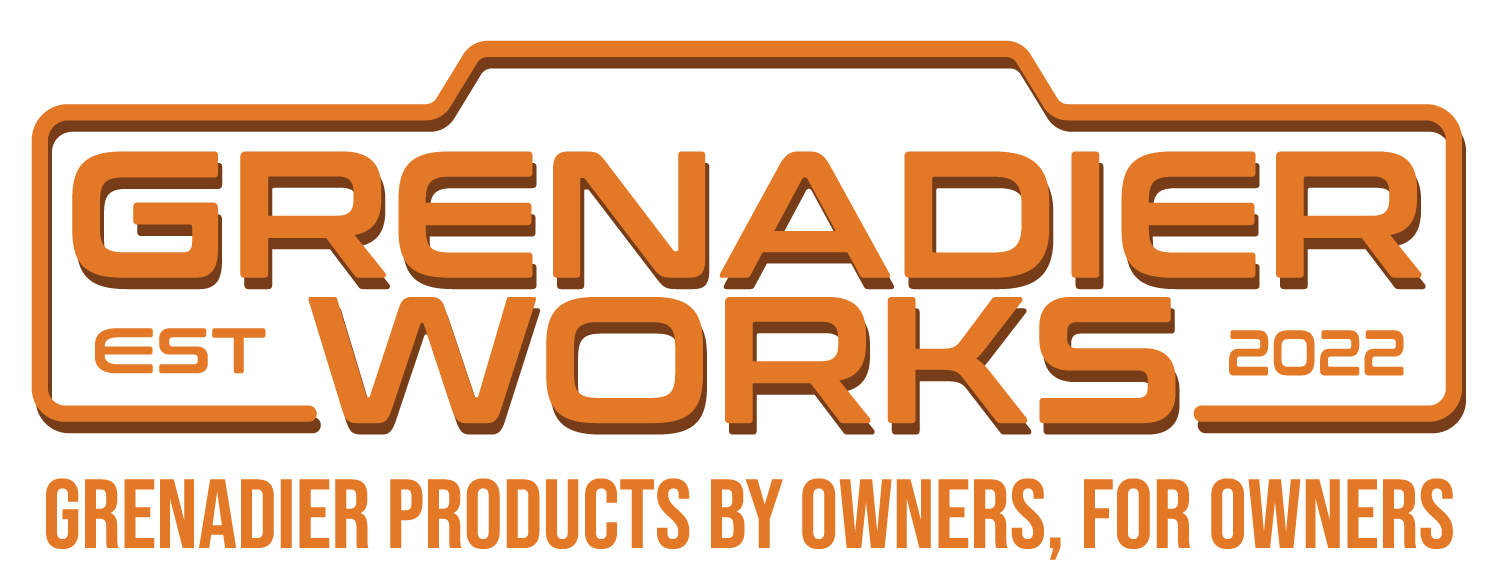The Grenadier Forum
Register a free account today to become a member! Once signed in, you'll be able to contribute to the community by adding your own topics, posts, and connect with other members through your own private inbox! INEOS Agents, Dealers or Commercial vendors please contact admin@theineosforum.com for a commercial account.
You are using an out of date browser. It may not display this or other websites correctly.
You should upgrade or use an alternative browser.
You should upgrade or use an alternative browser.
Fender / checker plate question
- Thread starter emax
- Start date
oh. I didn’t know that was a thing. Is that an official way to gauge checker plate strength? I’ve never had checker plate on anything I’ve owned.
The number of bars comprising each block.
Does anything else on the vehicle have this pattern? I'm partial to the look of conventional diamond plate. Perhaps the 5-bar version has better slip resistance?
From personal experience I can confidently say no. And before anyone says anything , read this linkDoes anything else on the vehicle have this pattern? I'm partial to the look of conventional diamond plate. Perhaps the 5-bar version has better slip resistance?
"Many well-intentioned people wrongly specify and fit profiled surfaces in high risk areas expressly to prevent slips
Profiled surface users may operate with a false assumption of increased grip and take less care, increasing the risk of slipping"
Metal and Profiled Surfaces
Advice from the HSA about the slip resistance of metal and profiled surfaces
oh. I didn’t know that was a thing. Is that an official way to gauge checker plate strength? I’ve never had checker plate on anything I’ve owned.
I have zero idea on strength or slip resistance. I can only share that I was first exposed to 5-bar when our club would import LR parts from the UK (1990’s). Much different and better aesthetics to diamond plate that is typical in the US.Does anything else on the vehicle have this pattern? I'm partial to the look of conventional diamond plate. Perhaps the 5-bar version has better slip resistance?
Best slip enhancement I have found is grip tape - the kind that removes skin if you brush against it.
The fenders are aluminum, as are the supplied rivers and checker plates.Isn’t anyone concerned about several rivets to attach these plates going into steel potentially causing rust?
Could you use something like 3M VHB tape to "glue" these on? No permanent holes in fender, but also not sure how hard it would be to get them off. I don't have any extensive experience in this area, just thinking of options.
The Stockton Beach fire pics of that burned-up Grenadier suggest the fenders are aluminum. Aluminum as the bonnet and doors. i.e. melted away in a fire, unlike all the steel right next to itIsn’t anyone concerned about several rivets to attach these plates going into steel potentially causing rust?
Citing the link posted by @Tazzieman...

The above pic accompanies the quote.
That's been suggested before (by me and others) but the consensus was that the plates may become a projectile in an front end collision unless well secured. If the US/ROW fenders do indeed have enough structural support I'd consider gluing down simple rubber mat.
Aluminium Chequerplate Slip Resistance
There is a misconception that aluminium chequerplate offers good slip resistanceThe above pic accompanies the quote.
Could you use something like 3M VHB tape to "glue" these on? No permanent holes in fender, but also not sure how hard it would be to get them off. I don't have any extensive experience in this area, just thinking of options.
That's been suggested before (by me and others) but the consensus was that the plates may become a projectile in an front end collision unless well secured. If the US/ROW fenders do indeed have enough structural support I'd consider gluing down simple rubber mat.
I must have missed that, good point. Thanks.That's been suggested before (by me and others) but the consensus was that the plates may become a projectile in a front end collision unless well secured. If the US/ROW fenders do indeed have enough structural support I'd consider gluing down simple rubber mat.
As far as I know, the plates have the tape, as well as, the rivets.Could you use something like 3M VHB tape to "glue" these on? No permanent holes in fender, but also not sure how hard it would be to get them off. I don't have any extensive experience in this area, just thinking of options.
Taking them off wouldn’t be too hard. Drill out the rivets and use fishing line to cut through the tape. Adhesive remover will take care of what’s left over.
I believe IG has said that the reinforced fenders themselves offer the ability to hold weight but the additon of the plates adds much more holding strength.Citing the link posted by @Tazzieman...
Aluminium Chequerplate Slip Resistance
There is a misconception that aluminium chequerplate offers good slip resistance
View attachment 7840612
If the US/ROW fenders do indeed have enough structural support I'd consider gluing down simple rubber mat.
- Local time
- 11:05 PM
- Joined
- Dec 22, 2022
- Messages
- 761
Hello everyone. Is there a picture or drawing of the reinforcement of the fenders? I am in Europe and would also like to install reinforcements and checker plates. But I don't want to buy new fenders.
There was one I remember seeing a while back. I’ve tried searching for you but can’t seem to find it. Perhaps @DCPU has one. He’s got a lot of Grenny pics. As a substitute, I believe in the factory tour of, and showcase of the assembly on YT, they showed the bones of the body as it was being assembled.Hello everyone. Is there a picture or drawing of the reinforcement of the fenders? I am in Europe and would also like to install reinforcements and checker plates. But I don't want to buy new fenders.
The way I think about is by comparing it to building a floor in a home, where the joists are the main structure of the Gren body and the “subfloor” is the skin of the Gren. As an extreme example, if cardboard is used as the subfloor and you step on it, your foot is going to go through. If you use plywood, it can now hold hundreds of pounds depending on how thick it is.@TCMBoulder
This was my recollection. I don’t disagree with your questioning how a thin sheet of aluminum can provide an additional 130 pounds of support, but that’s what IA claims.
IMHO, the checkerboard plate acts in a similar manner. It is filling the gap and distributing the load with a thicker material. The main body of the fender underneath is what is actually taking the weight.
That makes sense - good analogy.The way I think about is by comparing it to building a floor in a home, where the joists are the main structure of the Gren body and the “subfloor” is the skin of the Gren. As an extreme example, if cardboard is used as the subfloor and you step on it, your foot is going to go through. If you use plywood, it can now hold hundreds of pounds depending on how thick it is.
IMHO, the checkerboard plate acts in a similar manner. It is filling the gap and distributing the load with a thicker material. The main body of the fender underneath is what is actually taking the weight.
View attachment 7841231
So I have the answer on the reinforcing of the front wings.
"On the NON EU markets we have a large dense foam part directly under the flat surface of the Fender. This means on those Markets a standard 100Kg human can stand there on the checker plate...................on EU markets you cannot fit that foam part because of the PED PRO (Pedestrian Protection) requirements. If you were to be able to buy the parts and you wanted to remove your fenders you could fit it..............but it would not be legal on road. Off road of course much more is possible and people will always try and do what they want."
Sorry for the dodgy images, my phone camera is on the blink. (thrown one too many times by the kids......)


"On the NON EU markets we have a large dense foam part directly under the flat surface of the Fender. This means on those Markets a standard 100Kg human can stand there on the checker plate...................on EU markets you cannot fit that foam part because of the PED PRO (Pedestrian Protection) requirements. If you were to be able to buy the parts and you wanted to remove your fenders you could fit it..............but it would not be legal on road. Off road of course much more is possible and people will always try and do what they want."
Sorry for the dodgy images, my phone camera is on the blink. (thrown one too many times by the kids......)
The 5 bar plate acts as a gusset evenly distributing the load preventing the horizontal surface of the fender from bending.
Think of it this way. I have put raised floor on the 2nd floor of office buildings, and even with that added weight, the point load ability of the floor increased permitting heavy EMC drives. Same effect here. I have them as an order. I just wish they were in the white. Painted, especially black, is gonna show wear and scuffs. I may have them just give them to me so I can strip them and install myself. If I can remove the wheel liner for access I'll chamfer the holes and use stainless hex head screws. It'll look so much nicer than a rivet.
Think of it this way. I have put raised floor on the 2nd floor of office buildings, and even with that added weight, the point load ability of the floor increased permitting heavy EMC drives. Same effect here. I have them as an order. I just wish they were in the white. Painted, especially black, is gonna show wear and scuffs. I may have them just give them to me so I can strip them and install myself. If I can remove the wheel liner for access I'll chamfer the holes and use stainless hex head screws. It'll look so much nicer than a rivet.
Similar threads
- Replies
- 16
- Views
- 1K
- Replies
- 62
- Views
- 3K



